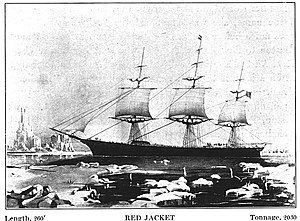Name Red Jacket Acquired 1854 Beam 13 m | Launched 2 Nov 1853 Length 109 m Tons burthen 2.091 million kg | |
 | ||
Notes In the immigrant trade; became an Australian and Indian coastal freighter, 1861. | ||
Red Jacket was a clipper ship, one of the largest and fastest ever built. She was also the first ship of the White Star Line company. She was named after Sagoyewatha, a famous Seneca Indian chief, called "Red Jacket" by settlers. She was designed by Samuel Hartt Pook, built by George Thomas in Rockland, Maine, and launched in 1853, the last ship to be launched from this yard.
Contents
Like many other fast clippers it is claimed that she is an extreme clipper, but this is technically incorrect. Extreme clippers were some of the clippers built in the period 1850 to 1852 only, and had at least a 40" dead rise at half floor. Being known as an extreme clipper was to be known as fast, and it became popular to call all fast clippers "extreme".
Voyages
On her first voyage, Red Jacket set the speed record for sailing ships crossing the Atlantic by traveling from New York to Liverpool in 13 days, 1 hour, 25 minutes, dock to dock.
She left Rockland under tow, and was rigged in New York. Her captain was a veteran packet ship commander, Asa Eldridge of Yarmouth, Massachusetts, and she had a crew of 65. On the passage to Liverpool, she averaged 14.5 knots (26.9 km/h), with sustained bursts of 17 knots (31.5 km/h).
A Collins Line steamer arriving in Liverpool (which had left New York two days before Red Jacket) reported that Red Jacket was just astern. As she entered the harbor, tugs tried to get lines aboard the clipper but she was traveling too fast. Thousands, alerted by the Collins Liner, watched as Eldridge shortened sail and backed the vessel into its berth.
A few days after the Red Jacket’s arrival in Liverpool, the accuracy of the ship’s log—and thus the integrity of her captain—was questioned in a letter to The Times of London, arguably the world’s most important newspaper at the time. The letter came from a highly authoritative source, Lloyd’s of London, but was signed only with the author’s initials. It prompted a fierce rebuttal the following day from a second correspondent who also did not disclose his name, but was clearly American. Three days later, the final word in this correspondence went to Asa Eldridge himself; The Times printed a letter from him (sent in his own name) in which he patiently explained why the original correspondent was wrong in his interpretation of the ship’s log.
At Liverpool, the Red Jacket had her bottom coppered and cabins fitted out for the Australian immigrant trade. She was purchased by Pilkington & Wilcox and other Liverpool investors with registry changing on April 24, 1854. (Most secondary sources say that the vessel was bought by the British a year later, copying a mistake made by earlier historians.) She was then chartered by the White Star Line for a run to Melbourne, Australia. Under Captain Samuel Reid (who owned 1/16 of her), she reached in Melbourne in 69 days. Only one clipper, James Baines, ever made the run faster.
Red Jacket served in the immigrant trade until 1867, when she became an Australian and Indian coastal freighter.
Fate of the ship
In 1872 Red Jacket joined clippers Marco Polo and Donald McKay, which "ended their days in the Quebec lumber trade," and became a lumber carrier from Quebec to London. In 1883 she was sold to Blandy Brothers, a Portuguese shipping company in the Madeira Islands as a coaling hulk. She was driven ashore in a gale in 1885.
